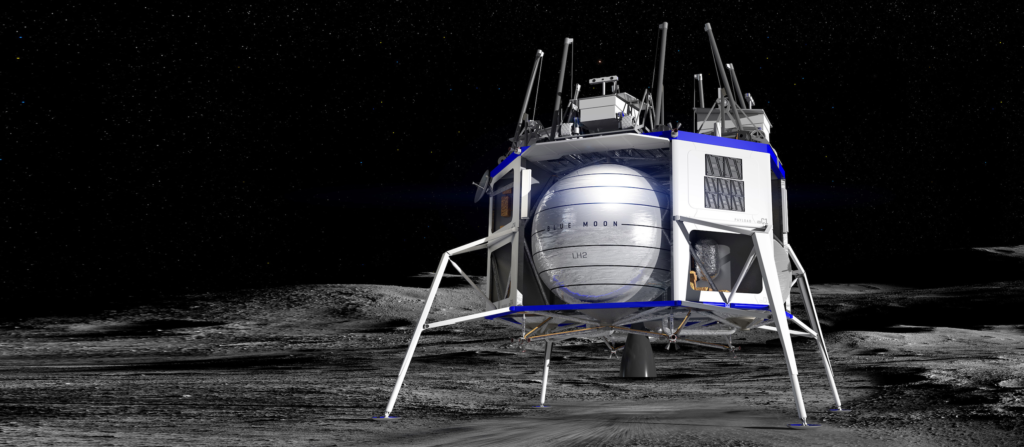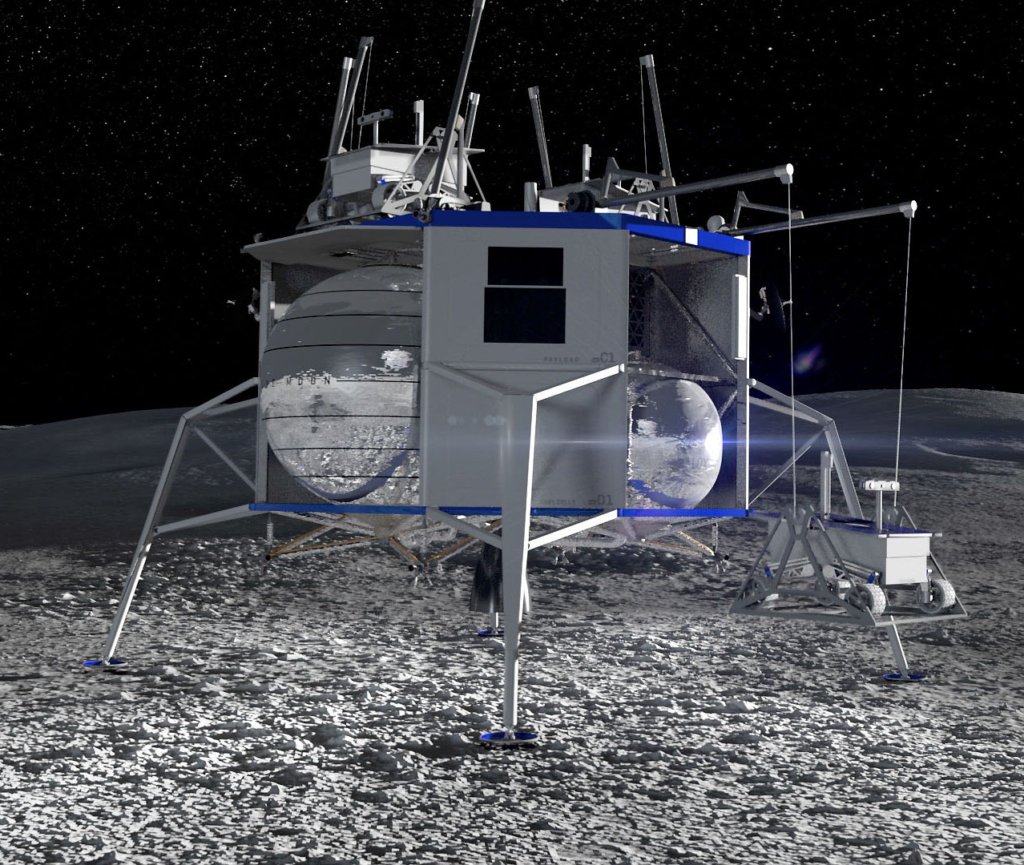
Why Blue Origin’s Lunar Lander Pick Is Important
An important part of the upcoming Artemis missions is the transfer from lunar orbit to the Lunar surface and back. For this job, NASA looked to the commercial industry and gave companies the opportunity to present lander designs and win significant contracts. While SpaceX won the first large contract for Artemis III and IV, Blue Origin was just picked as well.
Earlier today NASA announced that Blue Origin was selected to continue working on its lunar lander with the new contract worth $3.4 billion. This is a very big deal for Blue Origin who originally sued after SpaceX was picked. This being said, NASA strongly believes that there should be multiple options for the human landing system to try and ensure Artemis isn’t dependent on a single company.
As for Blue Origin, this contract is a very big deal and will allow them to continue developing, testing, and eventually using this lander hardware. Here I will go more in-depth into NASA’s new decision, the exact details of this contract, what we can expect to see in the coming months, and more.
$3.4 Billion Contract

Hours ago, NASA had a live announcement and soon tweeted, “We selected @BlueOrigin to develop the human landing system for the #Artemis V mission. This component for deep space transportation will help us in our goal of sending astronauts to the surface of the Moon and returning them home safely”
Blue Origin was one of two options for NASA to pick and while they didn’t specify who the other option was, we can assume it was either Northrop Grumman or Dynetics. In terms of what this means, Blue Origin will design, develop, test, and verify its Blue Moon lander to meet NASA’s human landing system requirements for recurring astronaut expeditions to the lunar surface, including docking with Gateway, a space station where crew transfer in lunar orbit. In addition to design and development work, the contract includes one uncrewed demonstration mission to the lunar surface before a crewed demo on the Artemis V mission in 2029.
For the Artemis V mission, NASA’s SLS (Space Launch System) rocket will launch four astronauts to lunar orbit aboard the Orion spacecraft. Once Orion docks with Gateway, two astronauts will transfer to Blue Origin’s human landing system for about a weeklong trip to the Moon’s South Pole region where they will conduct science and exploration activities.
As for why the agency selected a second company in addition to SpaceX, they were quoted saying, “Adding another human landing system partner to NASA’s Artemis program will increase competition, reduce costs to taxpayers, support a regular cadence of lunar landings, further invest in the lunar economy, and help NASA achieve its goals on and around the Moon in preparation for future astronaut missions to Mars.
Not only this, but Lisa Watson Morgan, manager for the Human Landing System Program commented, “Having two distinct lunar lander designs, with different approaches to how they meet NASA’s mission needs, provides more robustness and ensures a regular cadence of Moon landings. This competitive approach drives innovation, brings down costs, and invests in commercial capabilities to grow the business opportunities that can serve other customers and foster a lunar economy” she said.
The agency previously contracted SpaceX to demonstrate an initial human landing system for the Artemis III mission. Under that contract, the agency also directed SpaceX to evolve its design to meet the agency’s requirements for sustainable exploration and to demonstrate the lander on Artemis IV. As a result of the contract with Blue Origin to demonstrate on Artemis V a lander that meets these same sustainable lander requirements, including capabilities for increased crew size, longer mission duration, and delivery of more mass to the Moon, multiple providers will be available to compete for future opportunities to fulfill NASA’s lunar surface access needs for Artemis missions.
Looking at the timeline, Blue Origin, and its team have a decent amount of time with the primary mission 6 years from now in 2029. However, as partially mentioned before they are expected to complete a demo mission prior to that actual Artemis landing. Even still this will be years away and the company will have a significant amount of time to prepare. In reality, the company was originally planning years ago to be selected for the initial Artemis III landing. If they believed they could get the proper lunar lander ready in time for that mission then the Artemis V deadline should be realistic.
Lunar Lander

This contract is not just for Blue Origin but for the company’s revised National Team. The National Team partners include Lockheed Martin, Draper, Boeing, Astrobotic, and Honeybee Robotics. Under this contract, Blue Origin and its National Team partners will develop and fly both a lunar lander that can make a precision landing anywhere on the Moon’s surface and a cislunar transporter. With this new announcement also came a render of the system.
These vehicles are powered by LOX-LH2. They point out that the high-specific impulse of LOX-LH2 provides a dramatic advantage for high-energy deep space missions. Nevertheless, lower performing but more easily storable propellants (such as hydrazine and nitrogen tetroxide as used on the Apollo lunar landers) have been favored for these missions because of the problematic boil-off of LOX-LH2 during their long mission timelines.
In a company statement Blue Origin said, “Through this contract, we will move the state of the art forward by making high-performance LOX-LH2 a storable propellant combination. Under SLD, we will develop and fly solar-powered 20-degree Kelvin cryocoolers and the other technologies required to prevent LOX-LH2 boil-off. Future missions beyond the Moon, and enabling capabilities such as high-performance nuclear thermal propulsion, will benefit greatly from storable LH2. Blue Origin’s architecture also prepares for that future day when lunar ice can be used to manufacture LOX and LH2 propellants on the Moon” they said.
Blue Origin’s primary contribution will be Blue Moon. The lander features a cargo lander variant, designed to provide reliable, repeatable, and cost-effective delivery of a wide variety of payloads to the lunar surface. Based upon configuration and mission, Blue Origin is hoping to land up to several metric tons of payload on the Moon, ranging from large rovers, habitats, and ascent stages. The service is also meant to facilitate greater opportunities to conduct science, in-situ resource utilization, infrastructure development, and logistics missions for government, academia, and commercial customers.
The lander is planned to be capable of delivering 4,500 kilograms (9,900 lb) to the surface of the Moon. The cargo vehicle could also be used to support NASA activities in cis-lunar space, or transport payloads of ice from Shackleton Crater to support space activities. Blue Origin began development work on the lander in 2016, publicly disclosed the project in 2017, and unveiled a mock up of the Blue Moon lander in May 2019. The first projected mission for the craft as of 2018 was to have been a 2024 lunar south pole region landing, where it was proposed that a series of landings could be used to deliver the infrastructure for a Moon base.
Blue Origin’s original proposal—submitted along with several large US government space contractors including Lockheed Martin, Northrop Grumman, and Draper Laboratory, each acting as a subcontractor to Blue Origin who was to provide the descent element and also be the integration lead—was for the Integrated Lander Vehicle (ILV), a multi-element spacecraft consisting of an in-space transfer element and ascent element in addition to the Blue-provided descent element. In this case, each company was providing a different element of the main transfer vehicle. After not winning the original contract, the team changed with a few additions and the loss of Northrop Grumman.
We know that Blue Origin is still responsible for the main descent element which is extremely important. As far as progress, we have been seeing a lot more tests and an increase in production of the BE-7 engine and thrusters for the lunar lander. Last month the company tweeted saying, “Pictured here are nickel-based super alloy jackets that get vacuum-brazed onto the BE-7 slotted copper liner to complete the regen nozzle. The cone shape is hydraulically formed into the final nozzle contour using the tooling shown.”
In addition, a few months ago the company’s BE-7 team conducted another successful Thrust Chamber Assembly (TCA) test at NASA Marshall Space Flight Center Test Stand 116. These tests on an upgraded TCA bring the cumulative test time to more than 4000 seconds. At the time they made a comment that “This was a self-funded test as part of our campaign to advance our lunar capabilities, and we’re grateful for our @NASA_Marshall partners.” The BE-7 engine is an additively manufactured, high-performance, dual-expander cycle engine, generating 40 kN (10,000 lbf) thrust.
Conclusion
Blue Origin was just selected by NASA to provide a lunar lander and transport vehicle for Artemis V. The $3.4 Billion award will allow the company to continue development and eventually help astronauts land and leave the Moon. We will have to wait and see how it progresses and the impact it has on the space industry.
